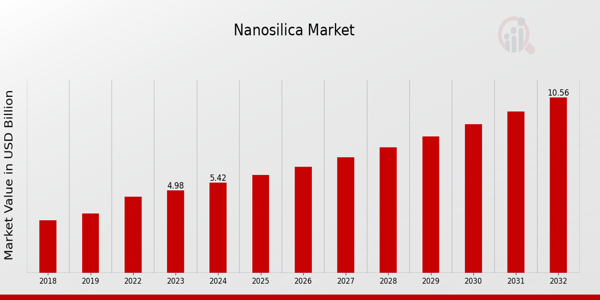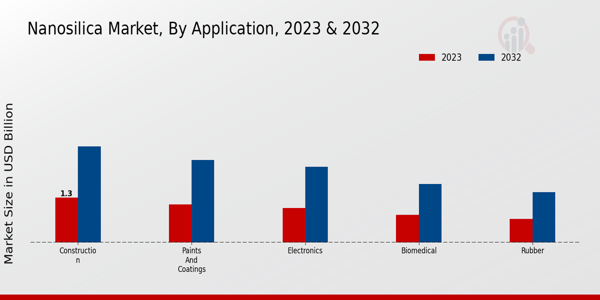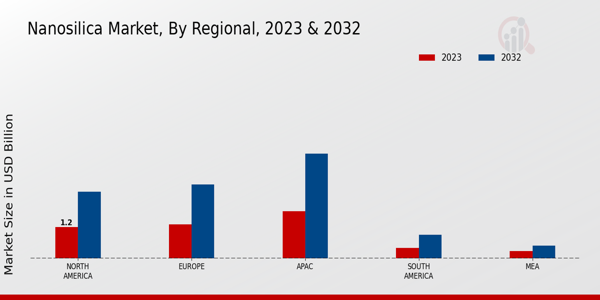Global Nano-silica Market Overview
The Nano-silica Market Size was estimated at 5.9 (USD Billion) in 2024. The Nano-silica Industry is expected to grow from 6.41 (USD Billion) in 2025 to 13.61 (USD Billion) by 2034. The Nano-silica Market CAGR (growth rate) is expected to be around 8.70% during the forecast period (2025 - 2034).
Key Nano-silica Market Trends Highlighted
The Nano-silica Market is witnessing notable growth driven by increasing demand for advanced materials across various industries. The rise in construction activities and the need for enhancing product performance in applications like coatings, electronics, and plastics have significantly propelled market expansion. Moreover, the growing emphasis on eco-friendly and sustainable materials has made nanosilica an attractive option, as it offers improved durability and reduced environmental impact. Fluctuations in raw material prices and technological advancements are also contributing to the dynamics of the market. Opportunities in the Nano-silica Market can be explored through the development of new applications and formulations.The growing trend of integrating nano-silica in composite materials presents significant potential, especially in sectors like automotive and aerospace, where lightweight and high-strength materials are in demand. Additionally, the rising awareness of the benefits of nano-silica in enhancing mechanical properties and thermal stability opens avenues for manufacturers to innovate and capture niche markets. Industries focusing on renewable energy and electronics hold particular promise as they increasingly seek materials that enhance performance and efficiency. Recent times have seen increasing research and development activities aimed at exploring the full potential of nanosilica.Collaborations between academic institutions and industry players are on the rise, leading to innovative product formulations and applications. Additionally, regulatory frameworks are evolving to accommodate the use of nanomaterials, which may further enhance market acceptance. Awareness programs and educational initiatives are also spreading knowledge about nano-silica, thus expanding its usage across multiple sectors. The focus on custom solutions tailored to specific industry needs signals a shift towards more specialized applications of nano-silica in the market landscape.
Source: Primary Research, Secondary Research, MRFR Database and Analyst Review
Nano-silica Market Drivers
Rising Demand for Advanced Materials
The Nano-silica Market Industry is witnessing a robust increase in demand for advanced materials across various sectors, including electronics, energy, and construction. Nanosilica, known for its exceptional properties, such as high surface area and enhanced mechanical strength, is increasingly utilized in manufacturing nanocomposites, which are favored for their lightweight and durable characteristics. The automotive and aerospace industries, in particular, are looking for materials that offer improved performance while reducing weight for better fuel efficiency, leading to higher consumption of nano-silica products.Additionally, the electronics industry has been integrating nano-silica into printed circuits and components to achieve higher conductivity and thermal stability. As a result of these trends, the Nano-silica Market Industry is expected to show a significant upward trajectory in the coming years as increasing investments in research and innovation continue to unlock new applications for nanosilica and drive demand further. Furthermore, sustainable construction initiatives promote the use of nano-silica in concrete applications, where it is employed to enhance durability and reduce the environmental footprint.This growing shift towards sustainability in construction materials is anticipated to play a crucial role in elevating the market prospects for nano-silica.
Technological Advancements in Production
Technological advancements in the production of nano-silica are playing a vital role in the growth of the Nano-silica Market Industry. As various manufacturing processes evolve, including the development of more efficient synthesis methods and purification techniques, the production of high-quality nano-silica has become both more feasible and cost-effective. Improved production methods have resulted in lower operational costs and reduced environmental impact, making it easier for manufacturers to meet the rising demand across multiple industries.Additionally, advancements in nanotechnology are enabling the design of customized nano-silica products that cater to specific industry needs, further widening the application spectrum.
Increasing Environmental Awareness
The Nano-silica Market Industry is also being driven by a growing awareness of environmental sustainability among consumers and industries alike. Many sectors are actively seeking eco-friendly materials that can contribute to sustainable development, and nano-silica fits this bill perfectly. Its use in concrete can enhance durability while decreasing the carbon footprint of construction projects. Moreover, in the coatings and adhesives markets, nano-silica is being employed in formulations that are less harmful to the environment.As regulatory frameworks become more stringent regarding environmental impact, industries are more inclined to incorporate nano-silica in their products to comply with regulations and meet consumer expectations for sustainability.
Nano-silica Market Segment Insights
Nano-silica Market Application Insights
The Nano-silica Market revenue is witnessing substantial growth, driven by varied applications across key sectors. In 2023, the market is valued at 4.98 USD Billion, with a projected increase to 10.56 USD Billion by 2032, highlighting a robust expansion trajectory. Within the application segment, Construction emerges as a dominant player, valued at 1.3 USD Billion in 2023 and expected to reach 2.8 USD Billion by 2032. The use of nano-silica in construction is significant due to its ability to enhance the strength and durability of materials, making it essential in modern building practices.The Paints and Coatings application also holds a notable position, starting at 1.1 USD Billion in 2023 and anticipated to grow to 2.4 USD Billion by 2032. Nanosilica contributes to the improvement of mechanical performance and chemical resistance in coatings, appealing to manufacturers focused on high-quality finishes.Electronics, valued at 1.0 USD Billion in 2023 and projected to reach 2.2 USD Billion in 2032, plays a critical role in the advancement of electronic components, as nano-silica improves thermal and electrical properties, making it increasingly essential as technology progresses. The Biomedical sector, with a valuation of 0.8 USD Billion in 2023 and an expected growth to 1.7 USD Billion by 2032, utilizes nano-silica in drug delivery systems and tissue engineering, indicating its importance in enhancing medical outcomes and patient care.Lastly, the Rubber application, starting at 0.68 USD Billion in 2023 and expected to grow to 1.46 USD Billion by 2032, leverages nanosilica for improved abrasion resistance and longevity of rubber products, providing manufacturers with a competitive edge in tire and industrial rubber production.The Rubber sector, while smaller, is gaining traction due to ongoing developments in material science and engineering. These dynamics underline the increasing importance of nano-silica across various industries, driven by the persistent need for enhanced product performance and functionality. The Nano-silica Market statistics reveal the growing investment in R, fostering innovation in applications, which presents opportunities for stakeholders aiming to capitalize on this evolving landscape. Market growth is fueled by an expanding range of applications, each characterized by distinct requirements and benefits that nano-silica addresses, supporting its role as a transformative material in today's industrial and commercial environments.Overall, the Nano-silica Market segmentation reflects a diverse application landscape, where each sector contributes significantly to market growth. The market data shows that Construction and Paints and Coatings hold majority stakes, driven by the increasing demand for high-performance materials, whereas Electronics and Biomedical applications highlight innovation and advancement.

Source: Primary Research, Secondary Research, MRFR Database and Analyst Review
Nano-silica Market Type Insights
The Nano-silica Market revenue reached 4.98 billion USD in 2023 and is projected to exhibit substantial growth dynamics driven by increasing industrial adoption and technological advancements. The market segmentation highlights several types, including Hydrophobic Nanosilica, Hydrophilic Nanosilica, Functionalized Nanosilica, and Colloidal Nanosilica, each contributing uniquely to the overall landscape. Hydrophobic Nanosilica is significant for its water-repellent properties, making it ideal for applications in paints, coatings, and adhesives, where moisture resistance is critical.Conversely, Hydrophilic Nanosilica plays a key role in enhancing the properties of products requiring water affinity, such as cosmetics and biomedical applications. Functionalized Nanosilica, designed for specific applications, showcases versatility by being tailored for enhanced compatibility with various materials, thereby expanding its market presence. Colloidal Nanosilica serves foundational uses in the electronics and automotive industries due to its ability to improve product durability and performance. The integration of these types not only strengthens the market growth but also presents opportunities for innovation in various end-user applications, making it a vibrant segment within the Nano-silica Market industry.The market growth reflects ongoing trends towards advanced materials and their applications across diverse industries.
Nano-silica Market End-Use Industry Insights
The Nano-silica Market revenue showcases significant growth potential in the End Use Industry, with an estimated market value of 4.98 USD billion in 2023. The industry is experiencing a steady increase, expected to reach 10.56 USD billion by 2032, underscoring the market growth driven by advancements in technology. The market segmentation highlights diverse applications across various sectors, with Automotive and Aerospace being prominent due to their demand for lightweight and durable materials that enhance performance. Healthcare is another vital area, benefiting from the antimicrobial properties of nano-silica in medical devices and drug delivery systems.The Consumer Goods sector also plays an important role, utilizing nano-silica to improve product durability and aesthetics. Moreover, the Energy sector sees significant opportunities for nano-silica in enhancing the efficiency of solar cells and batteries. As a result, these industries contribute substantially to the Nano-silica Market statistics, driven by a growing emphasis on sustainability and innovation, while facing challenges related to regulatory compliance and the high cost of raw materials. Overall, the diverse applications underscore the potential of the Nano-silica Market data to continue its upward trajectory in the coming years.
Nano-silica Market Form Insights
The Nano-silica Market, particularly in the Form segment, is witnessing significant growth and is expected to be valued at 4.98 USD Billion in 2023. This segment encompasses various forms, including powder and dispersion, which play crucial roles in driving industry applications. Powder form is widely utilized due to its versatility in enhancing the mechanical and thermal properties of materials, making it valuable in coatings, plastics, and rubber industries. Dispersion, on the other hand, is essential for its effectiveness in improving the performance of paints, adhesives, and sealants by ensuring uniform particle distribution.The ability of nano-silica to enhance product longevity and performance fuels its demand across multiple sectors, creating compelling opportunities for market expansion. As consumers increasingly seek high-performance materials, the significance of these forms in the Nano-silica Market continues to grow, reflecting notable trends in material innovations and sustainability. The projected market growth underscores a healthy trajectory driven by these forms, contributing to the overall Nano-silica Market revenue and statistics anticipated over the coming years.
Nano-silica Market Regional Insights
The Nano-silica Market is projected to achieve a valuation of 4.98 USD Billion in 2023, showcasing strong regional dynamics. North America and Europe respectively contributed 1.2 and 1.3 USD Billion to this market, indicating their significant engagement and adoption of nano-silica technologies. Asia-Pacific (APAC), on the other hand, leads the regional valuation with 1.8 USD Billion, highlighting its dominance and extensive industrial applications. The South America segment, valued at 0.4 USD Billion, and the Middle East Africa (MEA) segment at 0.28 USD Billion, represent smaller markets but show potential for growth.The APAC region's overarching presence is attributed to rapid industrialization and a growing demand for advanced materials. Concurrently, the North America and European markets are seeing an increase in investment towards R and sustainable technologies, emphasizing their vital role in the Nano-silica Market industry. Overall, the market growth reflects favorable trends towards nanomaterials across various sectors, providing substantial opportunities despite challenges posed by regulatory frameworks and competition.
Source: Primary Research, Secondary Research, MRFR Database and Analyst Review
Nano-silica Market Key Players and Competitive Insights:
The Nano-silica Market is characterized by intense competition among various players striving to leverage the unique properties of nano-silica across diverse applications such as rubber, coatings, and electronics. With the increasing demand for advanced materials, participants in the market are continually innovating to enhance product characteristics and develop new formulations. The competition is not only driven by product quality but also influenced by pricing strategies, supply chain efficiency, and technological advancements. As companies engage in strategic partnerships and collaborations, the competitive dynamics are further reshaped, resulting in a vibrant marketplace where market share and technological leadership are crucial for success.Nano-pore has established a significant foothold in the Nano-silica Market by focusing on high-purity nanosilica products that cater to various industrial applications. The company's strength lies in its unwavering commitment to innovation and sustainability, which resonates with the growing eco-friendly trends within the industry.Nano-Pore has made substantial investments in research and development, facilitating the introduction of unique nano-silica formulations that provide improved performance characteristics in applications, such as enhancing the durability of coatings and increasing the efficiency of nanocomposites. Their robust distribution network and strategic alliances enable them to reach diverse markets effectively, bolstering their presence within the landscape and enhancing their competitive edge.Cabot Corporation is another established player in the Nano-silica Market, renowned for its extensive expertise in advanced materials and specialty chemicals. The company's strong commitment to RD allows it to stay ahead of emerging market trends, developing innovative solutions tailored to customer needs. Cabot Corporation's nano-silica offerings are known for their versatility, finding applications in adhesives, sealants, and coatings, which positions the company favorably across various sectors. The organization maintains a considerable market presence, supported by its well-integrated supply chain and operational efficiencies. Furthermore, Cabot Corporation's emphasis on customer collaboration and technical support enhances its reputation for quality and reliability, allowing it to differentiate itself from competitors in an increasingly crowded market.
Key Companies in the Nano-silica Market Include
- NanoPore
- Cabot Corporation
- Wacker Chemie
- Advanced Materials
- Qingdao Ruisen Nano Technology
- Evonik Industries
- Hengsilica
- Nanosilica Technology
- Fuso Chemical
- Knauf Insulation
- Nanosilica Inc
- Nanoshell
- SiSiB Silica
- NANOSTEEL
Nano-silica Market Industry Developments
Recent developments in the Nano-silica Market reflect significant activities among key players. NanoPore has been making strides in the incorporation of nano-silica into advanced filtration materials, showing promising improvements in filtration efficiency. Cabot Corporation continues to expand its production capacity to meet the growing demand from industries seeking more sustainable solutions. Wacker Chemie has announced a strategic investment in new manufacturing processes that enhance the eco-friendliness of their nano-silica products. Advanced Materials recently launched a new line of nano-silica-enhancing coatings targeting the construction sector. In the realm of mergers and acquisitions, Evonik Industries has acquired a smaller firm specializing in nano-silica applications, strengthening its portfolio.Meanwhile, Hengsilica is in discussions for potential partnerships to leverage its research in nano-silica materials for various applications. Market valuations for companies like Nanosilica Technology and Knauf Insulation are showing upward trends, attributed to the increased adoption of nanosilica in the construction and automotive sectors. These dynamic shifts indicate a robust market poised for growth, highlighting the importance of nanomaterials in technological advancements and sustainable practices across diverse industries.
Nano-silica Market Segmentation Insights
Nano-silica Market Application Outlook
- Construction
- Paints and Coatings
- Electronics
- Biomedical
- Rubber
Nano-silica Market Type Outlook
- Hydrophobic Nanosilica
- Hydrophilic Nanosilica
- Functionalized Nanosilica
- Colloidal Nanosilica
Nano-silica Market End Use Industry Outlook
- Automotive
- Aerospace
- Healthcare
- Consumer Goods
- Energy
Nano-silica Market Form Outlook
Nano-silica Market Regional Outlook
- North America
- Europe
- South America
- Asia-Pacific
- Middle East and Africa
| Report Attribute/Metric |
Details |
| Market Size 2024 |
5.9 (USD Billion) |
| Market Size 2025 |
6.41 (USD Billion) |
| Market Size 2034 |
13.61 (USD Billion) |
| Compound Annual Growth Rate (CAGR) |
8.70% (2025 - 2034) |
| Report Coverage |
Revenue Forecast, Competitive Landscape, Growth Factors, and Trends |
| Base Year |
2024 |
| Market Forecast Period |
2025 - 2034 |
| Historical Data |
2020 - 2024 |
| Market Forecast Units |
USD Billion |
| Key Companies Profiled |
NanoPore, Cabot Corporation, Wacker Chemie, Advanced Materials, Qingdao Ruisen Nano Technology, Evonik Industries, Hengsilica, Nanosilica Technology, Fuso Chemical, Knauf Insulation, Nanosilica Inc, Nanoshell, SiSiB Silica, NANOSTEEL |
| Segments Covered |
Application, Type, End Use Industry, Form, Regional |
| Key Market Opportunities |
Growing demand in for electronics, Increasing applications in construction, Rising adoption in biomedical fields, Expanding use in the automotive sector, Enhanced performance in coatings and plastics |
| Key Market Dynamics |
Increasing demand in for electronics, Growth in automotive applications, Expanding usage in construction, Advancements in nanotechnology, Government regulations on materials |
| Countries Covered |
North America, Europe, APAC, South America, MEA |
Frequently Asked Questions (FAQ) :
The Nano-silica Market is expected to reach a value of 13.61 USD Billion by the year 2034.
The expected compound annual growth rate (CAGR) for the Nano-silica Market is 8.70% from 2025 to 2034.
The Asia-Pacific (APAC) region is projected to have the largest market share, valued at 4.0 USD Billion in 2032.
In 2023, the North American region is valued at 1.2 USD Billion, and it is expected to reach 2.55 USD Billion in 2032.
The Construction application segment is expected to grow significantly, reaching a value of 2.8 USD Billion by 2032.
The market size for the Rubber application is expected to be valued at 1.46 USD Billion in 2032.
Key players include NanoPore, Cabot Corporation, Wacker Chemie, and Evonik Industries, among others.
The Paints and Coatings application segment is expected to be valued at 2.4 USD Billion in 2032.
The Biomedical application is projected to reach a market value of 1.7 USD Billion in 2032.
The Europe region is expected to be valued at 2.82 USD Billion in 2032.

















